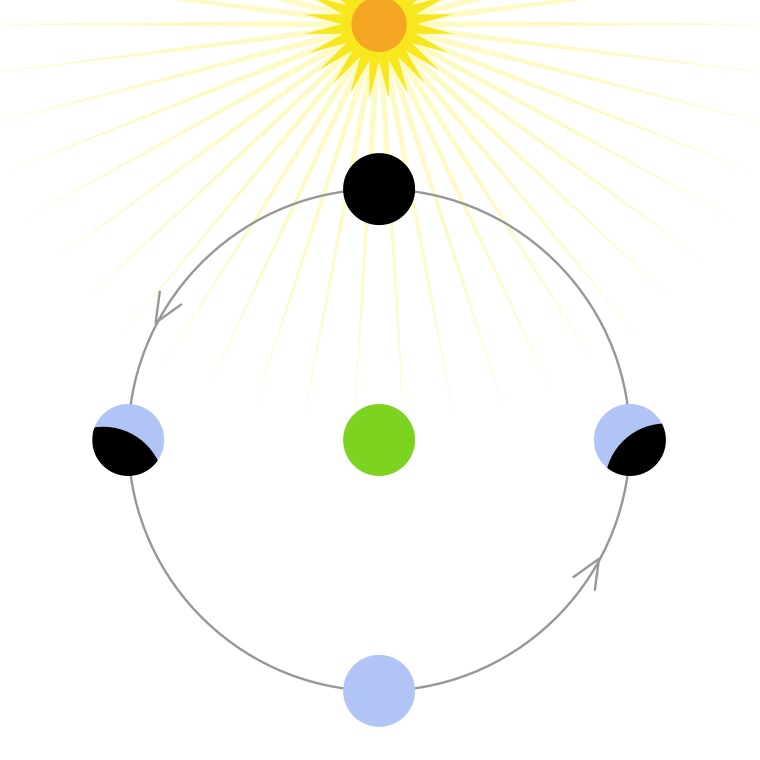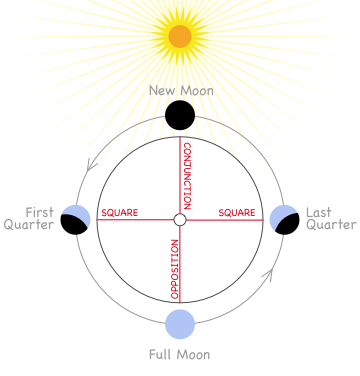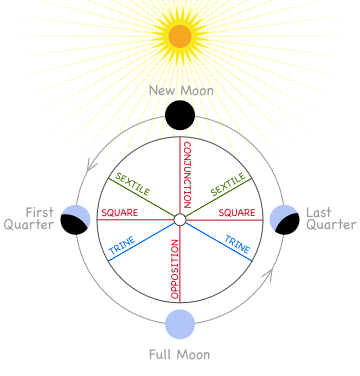
Waxing, waning, applying, separating aspects… sounds confusing? This multi-part story is aiming at demystifying these qualities of the astrological aspects and presenting a bigger picture of planetary cycles that makes for a deeper interpretation of an astrological chart.
Waxing, waning, applying, separating aspects… sounds confusing? This multi-part story is aiming at demystifying these qualities of the astrological aspects and presenting a bigger picture of planetary cycles that makes for a deeper interpretation of an astrological chart.
The key to understanding and interpreting an astrological chart often lies in the ability to interpret the aspects that planets make to each other. Another key is to see the aspects as stations within a larger planetary cycle.
It’s the combinations of these two key observations that translates an astrological chart into a cohesive narrative.
Are all squares equal?
Every astrological chart expresses itself through the language of its aspects — conjunctions, squares, oppositions, trines, sextiles plus numerous minor aspects — that describe complex relationships between planetary forces.
If we take, for example, a square aspect and ask ourselves: “Do all squares behave the same way?”
The correct answer would be: “Certainly not! It depends on the dynamic nature of the aspect.”
The nature of almost all aspects is influenced by them being qualified as waxing or waning. Well… this is not exactly true for all aspects.
There are two aspects — conjunction and opposition — that are neither waxing or waning. But they are still influenced by being qualified as either approaching or separating.
Okay, this is getting a bit too complex. How about starting from the beginning?
The Moon and its planetary cycle
The phases of the Moon present us with a perfect foundation to understand an idea of a planetary cycle. From the standpoint of the observer on the Earth, it works something like this…

Everything starts at the moment of an absolute unmanifested unity. Nothing yet has come to being, but the seeds are already sawn. This is the moment of the New Moon when the Moon is conjunct with the Sun.
After the infinitely brief moment of unity the Moon departs from its exact conjunction with the Sun and the creative manifesting moment unfolds. The seed begins to germinate and continues to do so until a brief moment of the First Quarter.
Past the First Quarter, the growth continues and reaches its fully manifested maximum at the moment of the Full Moon. The tiny sprout became a young tree, visible and standing on its own roots.
Further unfoldment and harvesting happens throughout the period after the Full Moon. This part of the cycle ripens the fruit and shines with the outpouring of creative flows.
The Last Quarter marks the beginning of the period of internalisation during which the key learnings are being reflected upon and new ideas and directions emerge.
These emerging ideas become the seeds for the next cycle that will begin with the coming next New Moon.
Thus the end of one planetary cycle becomes the beginning of the next cycle.
The Moon cycle as a sequence of aspects
It is clear that the New Moon is a conjunction between the Moon and the Sun. The Full Moon is therefore an opposition and the quarters are squares in between.

| Phase | Aspect | Degree |
|---|---|---|
| the New Moon | Conjunction | 0º |
| the First Quarter | Square | 90º |
| the Full Moon | Opposition | 180º |
| the Last Quarter | Square | 90º |
| next New Moon | Conjunction | 0º |
One may notice that there are two square aspects corresponding to the First and the Last Quarters. They are both squares but their meaning is very different!
And this is why we need to differentiate what kind of square we are looking at.
Waxing and waning Moon
The notion of waxing and waning process has been introduced to describe the visual effect of growth and shrinking of the Moon in the sky.
From the New Moon to the Full Moon it’s a waxing, or growing, phase.
From the Full Moon to the next New Moon it’s a waning, or shrinking, phase.
Adding this to the table above:
| Phase | Aspect | Degree | Growth |
|---|---|---|---|
| the New Moon | Conjunction | 0º | |
| the First Quarter | Square | 90º | Waxing |
| the Full Moon | Opposition | 180º | |
| the Last Quarter | Square | 90º | Waning |
| next New Moon | Conjunction | 0º |
Notice that conjunction and opposition are the two moments of equilibrium, there is neither growth nor recession. That’s why neither waxing nor waning quality applies to them.
Adding other major aspects
To take this further, one may add all other major aspects — sextiles (60º) and trines (120º) — and, again, discover that there are two sextiles and two trines.

| Phase | Aspect | Degree | Growth |
|---|---|---|---|
| the New Moon | Conjunction | 0º | |
| Sextile | 60º | Waxing | |
| the First Quarter | Square | 90º | Waxing |
| Trine | 120º | Waxing | |
| the Full Moon | Opposition | 180º | |
| Trine | 120º | Waning | |
| the Last Quarter | Square | 90º | Waning |
| Sextile | 60º | Waning | |
| next New Moon | Conjunction | 0º |
It is becoming more and more clear that the aspects between conjunction and opposition have different qualities when compared to the same aspects that happen after the moment of opposition.
A “waxing sextile” will have a different interpretation from a “waning sextile”. Both are still sextiles at the core but knowing their place in the bigger picture of a planetary cycle allows for a much more nuanced interpretation. And that’s what makes an excellent astrologer: the ability to read nuances.
How to interpret waxing and waning aspects
Threefive major aspects
Waxing aspects symbolise the process of development towards fullness.
The combined force of the two planets that form an aspect is developing from its initial “seed” state to the full potential. It’s the period of both youthful folly where freshness brings out blossoming and the process of building the foundations for future success.
Waning aspects symbolise the gathering of fruit and further learning. It’s the period of maturation and harvesting the benefits of previous phases. If the foundation building was successful and thorough, a larger and longer lasting structure can be erected on its strength that will invite even more fruitful times.
In human life the correspondence will be years 0–14 for the waxing period and years 14–28 for the waning period. If interested why, read the story about the phases of the Moon throughout the human life.
Each pair of planets has its own planetary cycle, not just the Moon and the Sun. The waxing-waning process applies to any pair of planets within their corresponding planetary cycle.
What about conjunction and opposition
Conjunction and opposition don’t really have meaningful waxing or waning qualities because those two aspects symbolise the state of either union or duality between the two planetary forces.
But this is not the end of the story! Conjunctions and oppositions have their own differentiators. The next part introduces applying and separating qualities of aspects.






































